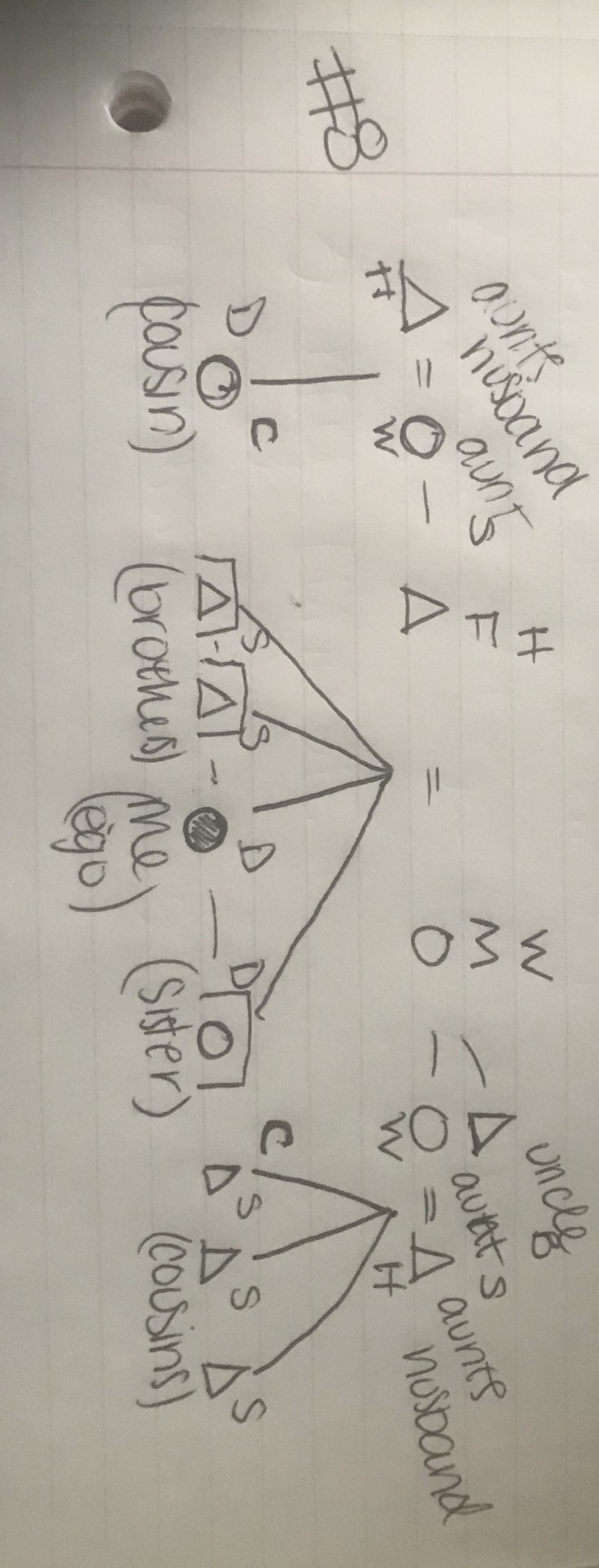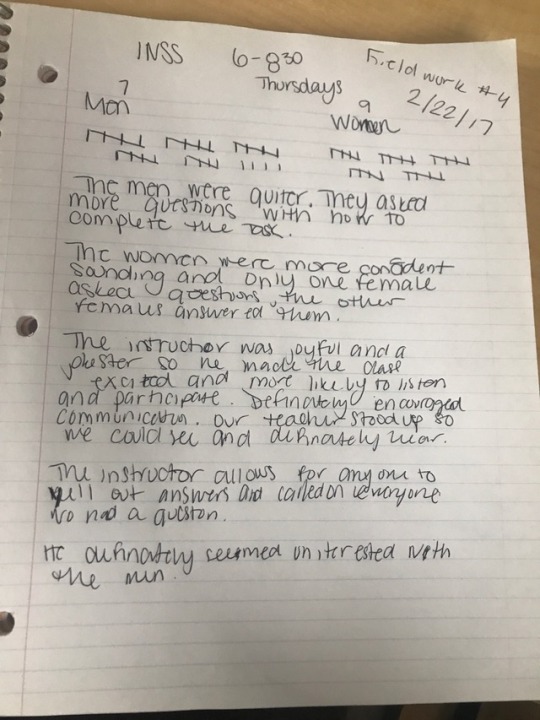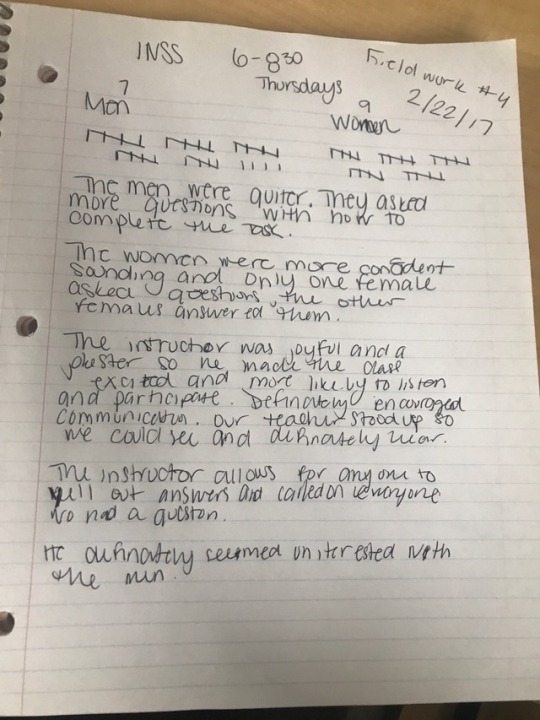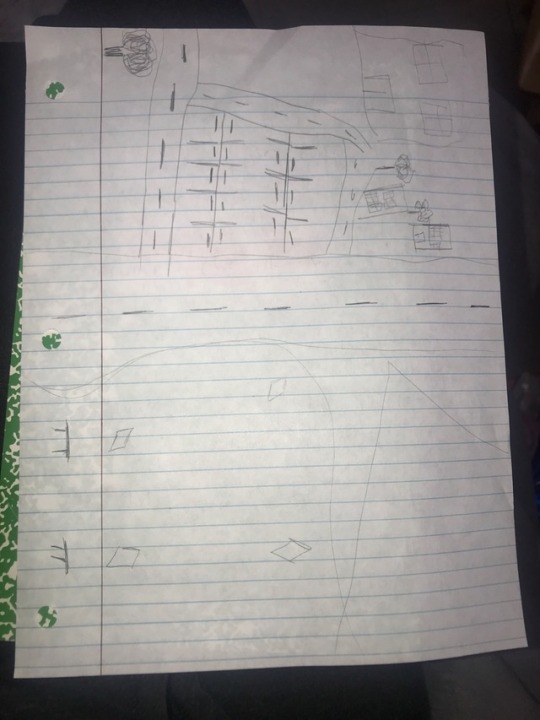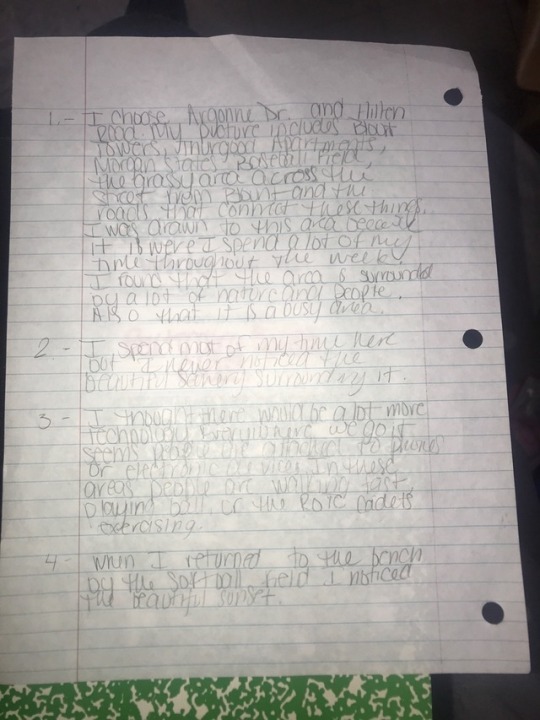Don't wanna be here? Send us removal request.
Text
Fieldwork #11
The transition from Ethiopia to the US was not just any walk in the park for a young man named Baharan Tesfaye. I met Bah thru mutual friends during my first semester at Morgan State. Bah is original native of ethopia and so are his parents they both work and live here in the U.S now. Baharan has been in the U.S since he was 12 he is now 19 so for the past 7 years he has been a U.S citizen and learning a new language, adjusting to the environment ( climate change ), price and time difference, and many other daily functions that i would only be able to imagine going thru being from a foreign place. For Bah the transition was much smother and he expressed that learning to understand the language and the culture is most exciting part about traveling here and becoming a citizen. Baharan also explained that the transition for his parents was much more difficult and they are all still learning how to cope and understand the language.
2 notes
·
View notes
Text
Fieldwork #10
“The Biography of a Chocolate Bar”
Write the biography of a chocolate bar. Before you begin writing, gather some information about the chocolate bar’s life. Buy one and put it on your desk. Now see if you can describe its life from the production of its ingredients until the moment you put it in your mouth. Consider the following questions:
1. What are the ingredients? (perhaps start with cocoa, the primary ingredient)
- chocolate, sugar, wheat flour, cocoa butter, nonfat milk, salt
2. Where do the ingredients come from?
- Chocolate comes from Cocoa beans from the cocoa tree
- Sugar comes from the stems of sugarcane
- Wheat flour comes from grinding/mashing the whole grain of wheat
- Cocoa butter comes from roasted cocoa beans
- Nonfat milk comes when the cream/milk fat is removed from whole milk
- Salt is from evaporating solution mined brine from the rock salt
3. how are the ingredients produced?
- Chocolate is produced when the beans of the tree are ferminated, dried, cleaned, then roasted.
- Sugar is produced by boiling and cooling the seeds along with sugar crystals.
- Wheat flour is produced when we do go is in the mill and is passed through a cleaning process to remove coarse.
- Cocoa butter is produced when the vegetable fat is extracted from the cocoa bean.
- Nonfat milk is produced when fat is removed from whole milk and vitamins are added.
- Salt is produced by evaporating solution mined brine.
4. What are the working conditions of the people who produce the cocoa?
- The working of us are poor, low paid, and little to now breaks.
5. How do the producers get the cocoa to the market?
- Cocoa is placed in the market and sold. It is then bought by locals and shipped to companies around the world.
6. How are the prices set?
- Prices are set usually 2$ per kilogram.
7. Which international corporations dominate the chocolate trade?
- Hershey, Nestle, and Mondelelez
8. Who regulates the trade?
- Fair trade
9. How is chocolate marketed?
- Some chocolate is marketed by using digital scales. Companies show competitors prices and compare the prices to their lower price. Companies also use advertising to appeal to all different types of audiences.
10. Where did you buy your chocolate bar?
- 7-Eleven
11. How much profit does a store owner make on one chocolate bar?
- about 7 percent
12. Are there hidden costs that are not included in the price you paid? (Consider underpayment of labor; environmental impact; government subsidies that are direct [to the company] and indirect [infrastructure such as roads, ports, bridges, and water systems]; and the healthcare costs created by the harvesting, transporting, processing, and eating of this food.)
- yes
13. Now that you’ve gathered some information about the components of this chocolate bar, write its biography. Tell the story of its life from the farming of its ingredients to the production and consumption.
- in foreign countries around the world chocolate is made from the cocoa beans of cocoa trees. The chocolate is then shipped to factories where they mix the chocolate with other ingredients to make chocolate bars and other chocolate treats. In these factories are hard-working citizens that are treated poorly. From the factory the chocolate candies or ship to stores all around the world. The stores sell the chocolate to people of all shapes and sizes.
1 note
·
View note
Text
Fieldwork #9
“Social Class and Inequality
http://m.sparknotes.com/sociology/social-stratification-and-inequality/section4/
Marx theory of social class is broken into two classes: Bourgeoisie and Proletariat. The two classes are divided and determined by upper class and lower class. The upper class owns their own properties and is able to do what they like with it. Where the lower class are the workers and has to work for what they want. The classes aren’t neither rich or poor but the “upper” class has more to offer than the lower.
In today’s society a lot of one particular race is known as the working class. However, race has nothing to do with it. In some scenarios it is obvious how some children would be born into owning a company that was previously ran by their ancestors. In the same generation their peers would be born into slavery and poverty, leaving them no choice but to work only making just enough to live.
1 note
·
View note
Photo
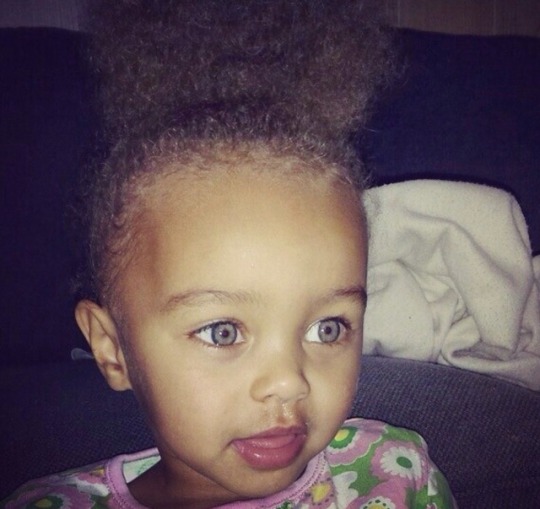
Fieldwork #6: The practice of classifying a child of mixed race ancestry in the more socially dominant of the parents' races. Although this child is black and white, she would only receive the privileges or perks of a black because of her tanned skin and hair texture.
1 note
·
View note
Photo
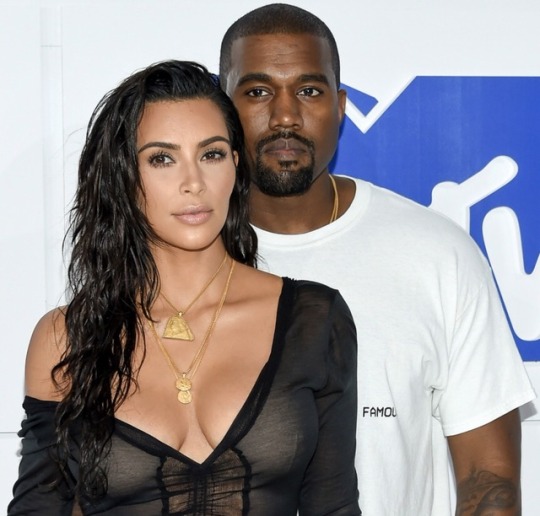
Fieldwork #6: The marrying of two different races. This photo shows Kim Kardashian’s West who is Caucasian and Kanye West who is African American. They have been married since 2014 and have 3 kids as of now (2017).
1 note
·
View note
Photo
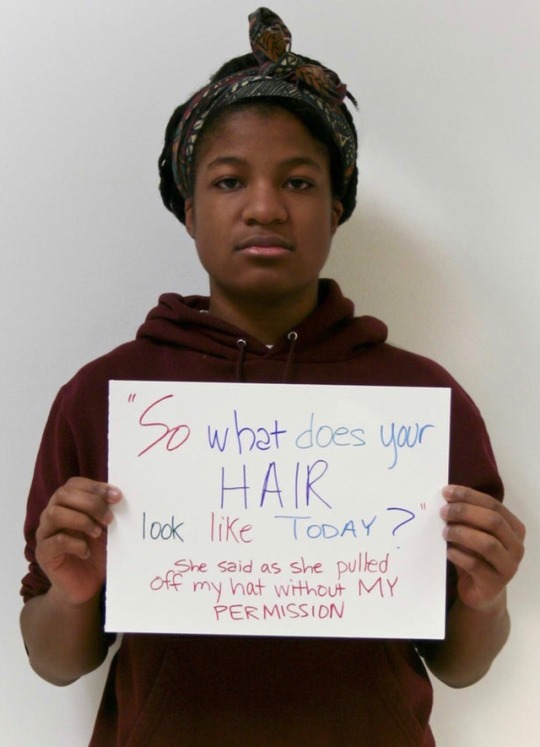
Fieldwork #6: Verbal, nonverbal, and environmental slights, snubs, or insults. This photo shows a black girl being harassed for having natural hair.
1 note
·
View note
Text
Fieldwork #5
“Human Family Tree”
1) Select and research one of the haplogroups mentioned in the film. Compare your findings to a modern racial category. How is the haplogroup different than the “race.”
I choose Haplogroup T also know as mT DNA. mT DNA was found in the Middle East and paired up with R in West Africa. A haplogroup is a biological explanation for a group of haplotypes that share a common ancestor. Haplotypes are genes that are inherited from one single parent. Haplogroups have a shared ancestor.
Race is a social group legitimized by hegemony. Race can be used to categorize people who look the same or have the same skin tone, hair texture, or looks. People of the same race can have completely different DNA where people from different races can have the same ancestors.
1 note
·
View note
Text
Fieldwork Assignment #5
“The Human Family Tree” Essay
After watching the National Geographic film, The Human Family Tree, please answer ONE of the following questions in essay format:
1) Select and research one of the haplogroups mentioned in the film. Compare your findings to a modern racial category. How is the haplogroup different than the “race.”
2) Use the film’s story of Dave’s genetic lineage to argue for or against the Out of Africa theory.
*Essays should be written in clear, grammatical English. They should be typed in 12-point font, be double spaced, and include more than one paragraph. Please remember and apply the principles of good essay writing that you learned in English 101. Your grade will be calculated using the essay writing rubric that has been distributed. Use the rubric to help craft your essay.
*All ideas should be your own—plagiarism of any kind is strictly prohibited.
Due Sun ¾ @ 11:59 pm
31 notes
·
View notes
Photo
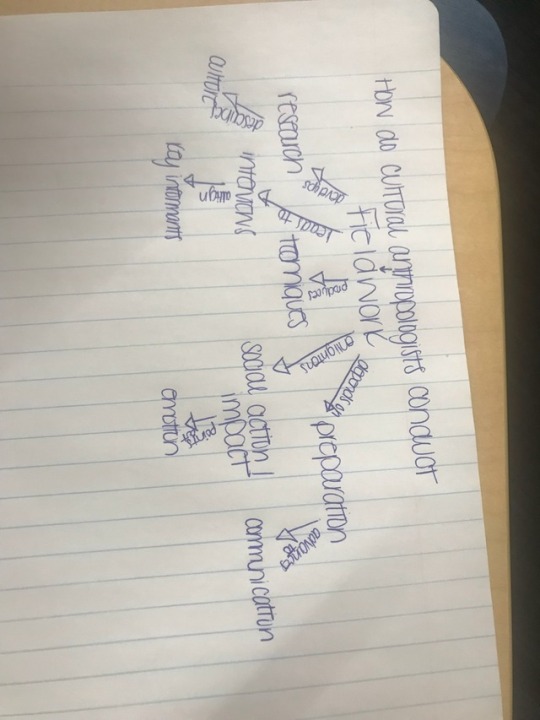
How do cultural anthropologist conduct fieldwork
2 notes
·
View notes
Text
I agree teens want a lot of things that we don’t need but adults definitely do too, and often times they get it because they have the finances.
college student and consumer culture
being a teenager causes you to usually want many things. because of the many things i want and need as i teenager i believe i contribute to consumer culture.listed below are the items i want and need they are currently in my dorm room.
needs- toothbrush, toothpaste, lotion, deodorant, hair products, refrigerator, school supplies, cell phone, covers, trashcan, hamper, bins, shoes, keys,silver ware
wants-pillows,dorm lights, perfume, posters, mirrors, television, lamp, makeup, flat iron , wand curl, snacks, jewelry , scarves, makeup,microwave
most items i have may not be considered necessities in other cultures. other cultures may be able to go without many things i decide i may “need”. others cultures may fell differently as well as have a totally different list.
my amount for both wants and needs list is pretty accurate and almost even. the items listed on my needs list would usually be located on many kids list. they are items used by a everyday person. the items listed on my wants list are usually for females. i have many girly things that you see on my list and you will not see on a boys list. so many girls my age would most likely have a similar list.so this list would be based on gender and age. because even an older female may not use certain items on my list.
2 notes
·
View notes
Text
Electronics and clothes were the highest categories for both of us!
Fieldwork Assignment 2: College Students and Consumer Culture
Electronics -iPhone -MacBook -iPad 2nd Generation -iPad Pro -Television -Printer -Portable Speaker
Cost: 3,000+
School Supplies -Pens -Pencils -5 subject notebooks -Folders -Paper clips -Loose Leaf -Text books
Cost: $50+
Appliances -Fridge -Microwave -Lamp -Fan -Vacuum -Blowdryer -Flat iron
Cost: $1,000
Clothes -10+ Sweaters -5+ Jackets -20+ Jeans -10+ Sweatpants -20+ Shirts -Socks -Dresses -10+Sneakers and boots
Cost: $2,000+
Furniture and Bedding
-4 Decorative Pillows -Chair -2 Down Blankets -3 Sheet sets -3 Regular Pillows -Mattress Pad -Trash can
Cost: $100+
Toiletries and Hygiene Products
-Feminine Products -Toothbrush -Toothpaste -Body wash -Lotion -Deodorant -Face wash
Cost: $50+
Transportation -Lyft/ Uber -Shuttle -My legs
Cost: $16+ per ride
Other items -Food -Cleaning supplies -Air fresheners -Plastic Spoons and Forks -Bowls
Cost: $50+
I listed a couple of items that I saw around my room. The items that are bolded are my needs while the items that want are italicized. My wants and needs might be quite different than someone else’s because these are the things that are essential to my life. The things that I have listed, someone else might not have therefore they won’t have a use for it.
I noticed that the things that I considered to be my needs are things that I use on a daily basis that make my life easier such as my phone, my Macbook. Some of the things that I also listed as needs include feminine and hygiene products. Those are products that all girls and most people would consider to be important. Now some of the things that I consider to be wants are things such as my iPad pro and my jeans are on there because I already have an iPad that I use so it’s just an extra thing to have. Also, my jeans because I rarely wear jeans I normally wear sweatpants and in the summer leggings and shorts. I noticed that the wants are also things that I barely use oppose to my list of needs. I also listed estimates of what everything in each category probably add up together.
2 notes
·
View notes
Text
Nice to see we have a lot of the same items!
Field work Journal Ch.2: The Culture of Consumerism
Growing up in a consumer culture you don’t always think about your material possessions as needs vs wants. Everything seems like a need as a result of consumerism and societal teachings. Consumer culture teaches people to buy buy buy, without second guessing if the products in question are vital to life. As a college student I’m learning that i can’t always afford to participate in this culture.
Clothes and Accessories
Coat
hoodies: 4
Jackets:
Shirts 10+
bottoms: 10+
bathrobe
shoes: 5+ pairs
scarf
bags: 4
Toiletries and cleaning items
Body wash
lotion and face cream
face wash
deodorant
tea tree & reship oil
perfumes
shampoo & conditioner
hair tools: brush/combs/clips
toothpaste and toothbrush
dish soap and sponge
clorox wipes
cotton balls
laundry detergent
towels and washcloths
Makeup
Foundation
concealer
brow pomade
brushes
chapstick
lipstick/gloss
Appliances
Microwave
mini fridge
desk lamp
printer
Electronics
Iphone
macbook pro
headphones: 2 pairs
chargers
Furniture
Bed & bedding
pillows
knit blanket
desk
chair
trash can
closet
trunk
storage bin
Transportation
Uber
School supplies
journals
folders
paper
pens/pencils/highlighters
post-its
stapler/staples
textbooks
binder
scissors
paperclips
Other items
bear card
state id
food: chips/noodles/soup/etc
reusable water bottle
All of the items crossed out have been categorized as my wants, and items remaining are my needs. Certain items such as clothing are both needs and wants. I need shirts, shoes, and jackets but I don’t necessarily need so many of each item
My wants are heavily influence by consumer culture. Western consumers are obsessed with everything happening quickly and conveniently. Society has also taught myself and other consumers that you can never have enough of something. Even if an item starts out as a need, such as clothing which protects us from the elements, consumer culture has brainwashed us to believe that we should have dozens of every article of clothing; which is excessive.
9 notes
·
View notes
Photo
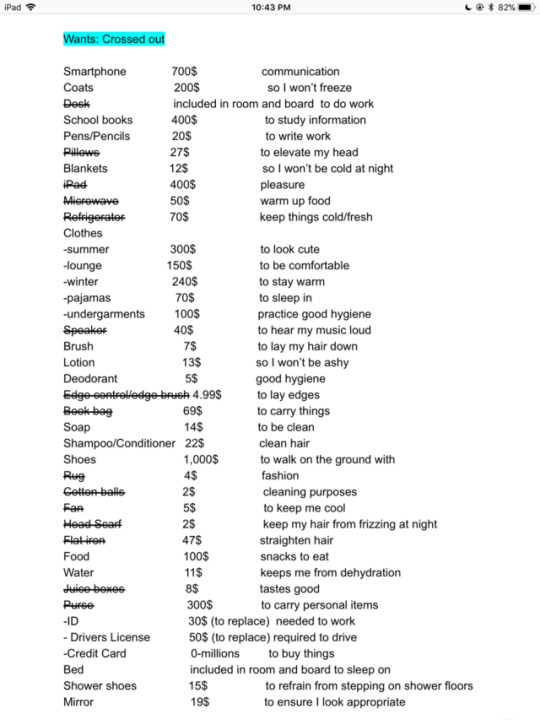
I feel as though my list isn’t based on gender, ethnicity, or age. Everything on my list can be used by any and everyone.
2 notes
·
View notes
